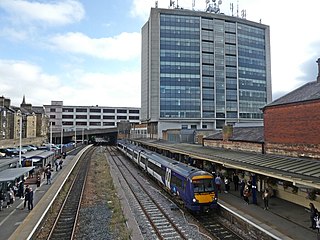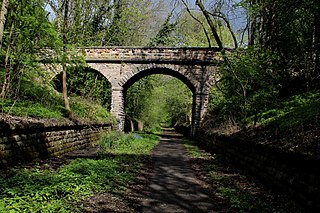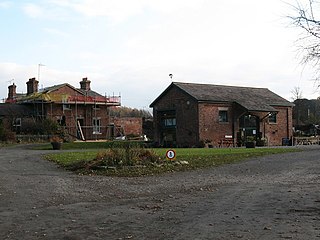
Tadcaster is a market town and civil parish in North Yorkshire, England, 15 miles (24 km) north-east of Leeds and 10 miles (16 km) south-west of York. Its historical importance from Roman times onward was largely as the lowest road crossing-point on the River Wharfe until the construction of the A64 Tadcaster by-pass some 660 yards (600 m) to the south, in 1978. There are two rail crossings downstream of the town before the Wharfe joins the River Ouse near Cawood.

The Harrogate line is a passenger rail line through parts of North Yorkshire and the West Yorkshire area of northern England connecting Leeds to York by way of Harrogate and Knaresborough. Service on the line is operated by Northern, with a few additional workings by London North Eastern Railway starting and terminating at Harrogate. West Yorkshire Metro's bus and rail MetroCard ticket is available for journeys between Leeds and Harrogate.

Cross Gates railway station serves Cross Gates, an area in Leeds, West Yorkshire, England. It lies on the Selby Line, operated by Northern 4.25 miles (7 km) east of Leeds railway station.

Church Fenton railway station serves the village of Church Fenton in North Yorkshire, England. It is situated where the Cross Country Route from Leeds to York meets the Dearne Valley line from Sheffield to York, just under 10.75 miles (17 km) from York.

Harrogate railway station serves the town of Harrogate in North Yorkshire, England. Located on the Harrogate Line it is 18.25 miles (29 km) north of Leeds. Northern Trains operate the station and provide local passenger train services, with a London North Eastern Railway service to and from London King's Cross running six times per day.

Millers Dale railway station was in Millers Dale, near Tideswell, in Derbyshire, England. It was opened in 1863 by the Midland Railway on its line from Rowsley, extending the Manchester, Buxton, Matlock and Midlands Junction Railway. It closed in 1967 and the site is now used as a car park for the Monsal Trail, which follows the trackbed.

Stutton is a small village in the Selby District of North Yorkshire, England, a mile south-west of Tadcaster.

The York and North Midland Railway (Y&NMR) was an English railway company that opened in 1839 connecting York with the Leeds and Selby Railway, and in 1840 extended this line to meet the North Midland Railway at Normanton near Leeds. Its first chairman was the railway financier George Hudson, who had been called the railway king.

There are eleven disused railway stations on the Exeter to Plymouth line between Exeter St Davids and Plymouth Millbay in Devon, England. At eight of these there are visible remains.

Wetherby railway station was built on the North Eastern Railway's Cross Gates to Wetherby Line on Linton Road. It replaced an earlier station on York Road which had opened on 1 May 1876.

Wetherby railway station was a station serving the town of Wetherby in West Yorkshire, England. It was first built on the York and North Midland Railway Company's Harrogate to Church Fenton Line and the station was situated on York Road. The goods shed remains, situated off York Road, and is now a dance venue.

Wetherby Racecourse railway station was a railway station on the Harrogate to Church Fenton Line serving Wetherby Racecourse in Wetherby, West Yorkshire, England.

The Cross Gates–Wetherby line is a former railway line in West Yorkshire, England, between Cross Gates, near Leeds, and Wetherby. The line opened 1876 and closed 1964.

The Harrogate–Church Fenton line was a railway line in North Yorkshire, opened by the York and North Midland Railway between 1847 and 1848, linking Harrogate and Church Fenton.

Stutton railway station was a railway station in Stutton, North Yorkshire, on the Harrogate to Church Fenton Line. The station opened on 10 August 1847 and closed to passenger traffic on 30 June 1905. It remained open to goods traffic until it closed completely on 6 July 1964.

The Leeds and York Railway was a proposed railway line, promoted in the mid 1840s, intended to connect York and Leeds. The line lost a significant promoter, the Manchester and Leeds Railway in 1845/6 as a result of a non-competition arrangement between that company and the York and North Midland Railway.

Thorp Arch railway station (before 12 June 1961 called Thorp Arch (Boston Spa)) was a station in the parish of Wetherby, West Yorkshire, on the Harrogate–Church Fenton line. It opened on 10 August 1847 and served nearby Thorp Arch as well as Boston Spa. The station closed to passengers on 6 January 1964 and completely on 10 August 1964.

Newton Kyme railway station was a railway station on the former Harrogate–Church Fenton line, serving the village of Newton Kyme near Tadcaster in North Yorkshire. It handled freight and passenger traffic.

Spofforth railway station was a station on the Harrogate–Church Fenton line in Spofforth, North Yorkshire.

Masham railway station was the terminus of the Melmerby to Masham branch line serving the town of Masham in North Yorkshire, England. It was on the eastern side of the River Ure, so as such, was actually in Burton-on-Ure. The line operated between 1875 and 1931 for passenger traffic, but was retained for minimal freight train use until 1963.




















